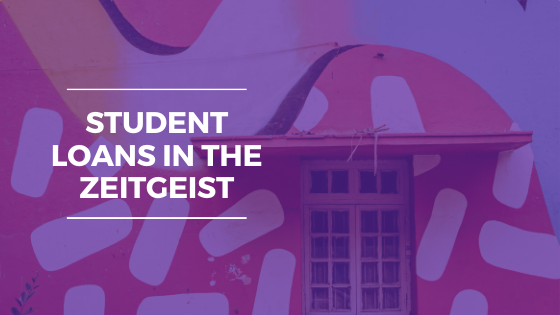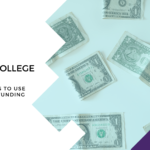Student loan debt is a juggernaut plowing through the earning potential of millions. The burden has topped $1.5 trillion and impacts more than 44 million Americans. It’s size and weight are second only to mortgage debt. As we bear witness to the financial impact it makes, it’s no surprise that we’re starting to see indelible cultural changes.
From the very words we speak to the way the wealthy donate their money, student loans have officially reached influencer status.
Changes in our language.
Language is inseparable from culture. Word usage is a helpful snapshot of the culture at the time. As a cultural event increases in frequency, words describing the happenings increase to match. Student loans mirror this phenomenon almost exactly. As college costs have increased, so has usage of the phrase “student loans”.
Real-time word usage: The cost of tuition in 2008 was 2.25x higher than in 1980. In parallel, usage of the phrase “student loans” in 2008 was 2.19x higher than in 1980, according to a Google Ngram search.
Read all about it, for fun.
You can read entire works of fiction dedicated to protagonists with crushing student loans. The fight of fictional characters who will do anything to pay off their student loan debt is particularly captivating in Camille Perri’s The Assistants. There’s also John Grisham’s legal-thriller Rooster Bar. Both books describe desperate actions born from the unshakeable & suffocating weight of student loan debt. While entertaining to read, borrowers can almost imagine themselves in the shoes of the protagonists and lose themselves in thoughts of escaping their own debt.
The siren song of student loans.
Student loan debt crops up in music, spanning genres and generations. Song lyrics by Jimmy Buffett and Kendrick Lamar extol the desire to escape the grasp of student loans. Kanye West laments the burden of paying them back in Late. Dee-1’s Sallie Mae Back is a celebration jam dedicated solely to the repayment of student loan debt. I think every borrower wants to be singing this chorus “I finished paying Sallie Mae back Mae back”.
Watch & learn.
You’ll even see student loans on TV. TruTv’s Paid Off is a gameshow where contestants compete in a trivia style match for their chance to win enough money to pay off their student loans. The gameshow offers a lighthearted approach to tackling the student loan beast, though a common phrase from the host brings the point sadly home, “…it doesn’t cover everything, but
hopefully it can take some of the pressure off.”
Entertainment may be the empathetic side of cultural change, but what about the action side? Seismic shifts in philanthropic giving, fintech, and personal gift-giving are changing the way borrowers repay their debt.
Philanthropic giving takes aim at student loans.
During the last fiscal year, nearly $47 billion was donated directly to universities. The money may be used for operations and with increasing frequency is being directed to financial aid. However, this year Robert Smith made an unprecedented gift to Morehouse College Class of 2019 when he decided to provide a grant to directly repay the student loans of 396 graduates. It’s a gift valued at an estimated $40 million. Giving directly to those impacted by their debt is uncommon.
So many borrowers desire transparency and efficiency of giving, and this type of gift is exhilarating. Perhaps this sets a new bar for donors, that rather than relying on institutions to distribute money to causes that produce long term societal impact, an individual simply wipes the financial slate clean, without a middle man to slow the flow of cash.
Wealthy billionaires aren’t the only ones getting in on the direct-to-borrower cash exchange.
Employee benefits are here to help.
Employers like Hulu, Estee Lauder, and many more are providing contributions directly to their employees’ student loans as part of a competitive benefits package. And these contributions don’t only attract younger workers, the fastest growing group of student loan borrowers is 60+.
Gifts from billionaires and employer contributions stand out, but borrowers aren’t waiting for employers or philanthropists to lend a helping hand.
It takes a village.
The dream of becoming student loan debt free has become so pervasive that borrowers are looking for help from their personal communities. Crowdfunding has become a popular venue for borrowers looking to clear their student loan debt. GoFundMe shows nearly 27,000 campaigns when searching for “student loan”.
Leveraging technology to repay debt.
Last but not least, the technology most borrowers carry in their pockets can be leveraged to help fight off student loans. Rounding apps such as Quoin & ChangEd round up purchases to the nearest dollar and collect that change to make a contribution to a designated student loan account.
The gaming app, Givling, is a unique trivia style game that allows participants to take part in three-person team quizzes and the highest scoring team splits the cash reward.
Despite the proposals of political hopefuls, it’s likely student loans are here for the foreseeable future, so grab a book, put on some tunes, or watch a gameshow as you read about the next philanthropist and employer helping borrowers out. Don’t forget to check that push notification.




